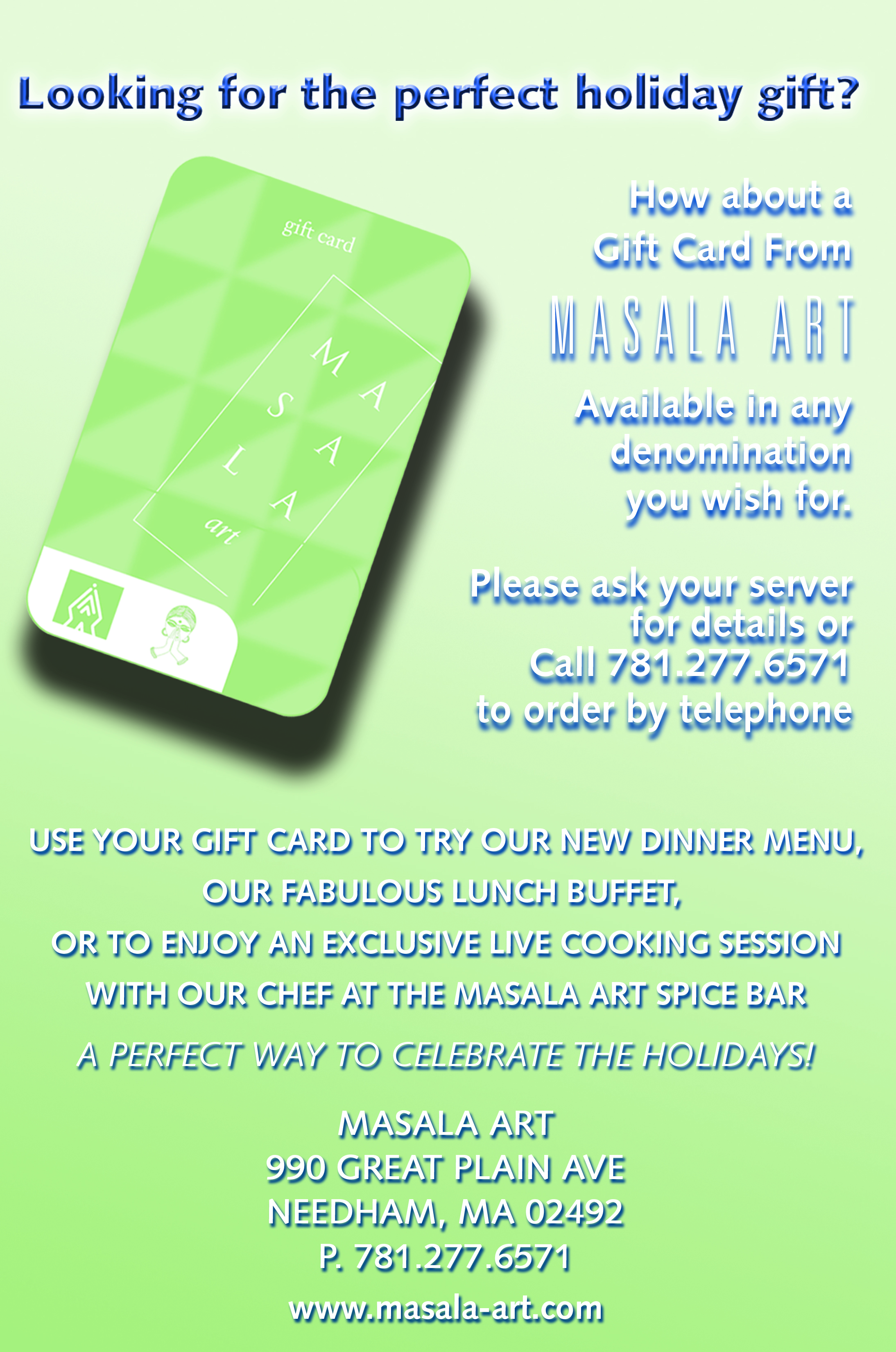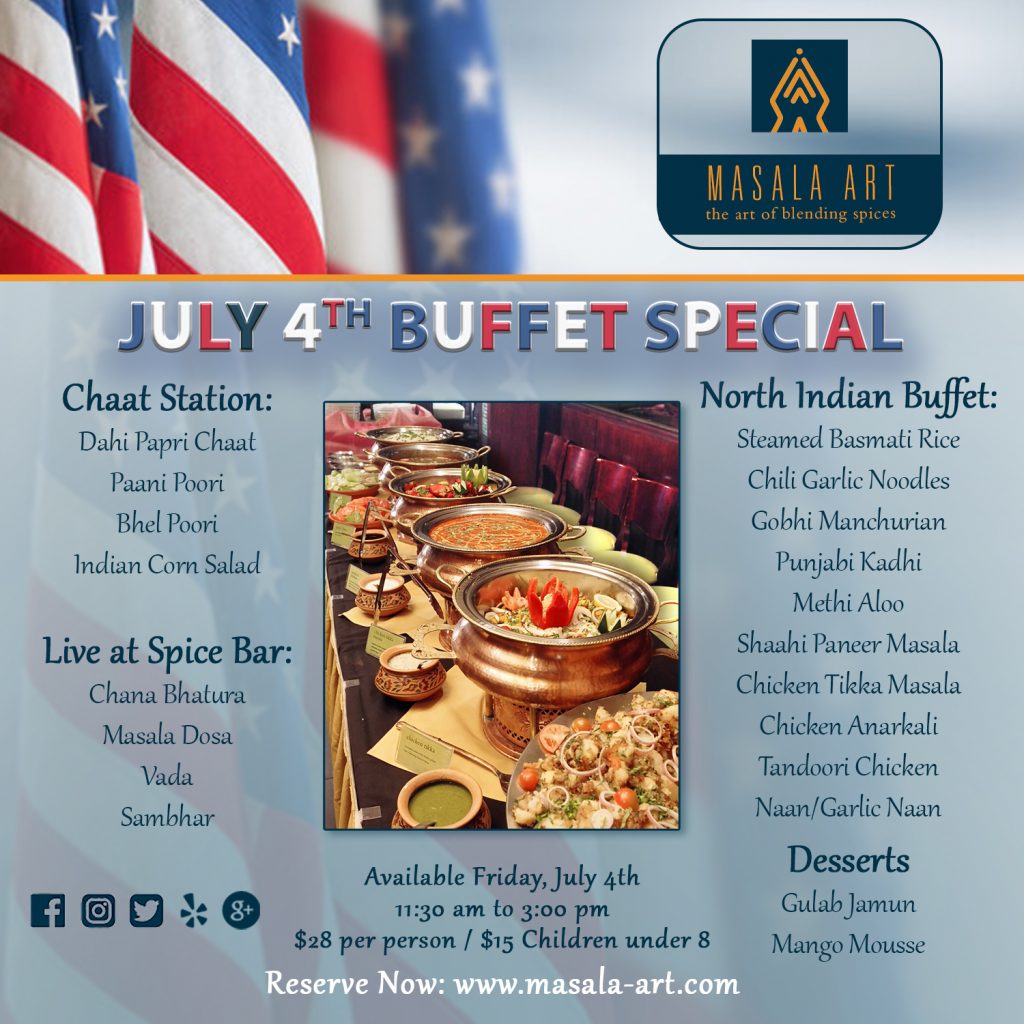
Gift Cards From Masala Art

BLACK FRIDAY LUNCH BUFFET SPECIAL
FRIDAY, NOVEMBER 27, 2015
11:30 AM TO 3:30 P.M.
MAKE YOUR RESERVATION NOW BY CALLING 781.336.4595
$15/person + Tax
(Children 10 and under, $11.00 per child)
THE CHAAT STATION
CHAAT IS A NUTRITIOUS ROADSIDE SNACK FOUND IN NORTHERN INDIA. CHOOSE YOUR OWN TOPPINGS AND FILLINGS AND CREATE YOUR OWN CHAAT!
Chaat Papri
A nutritious easy-to-make Indian snack comprised of graham flour crackers topped with whipped yogurt, chickpeas, diced potatoes, chutneys, various herbs and spices
Paani Poori
Graham flour puffs filled with chickpeas, diced potatoes and spicy water called ‘jaljeera’
Bhel Poori
Crispy rice puffs tossed in our tangy sauce with green chilies and lemon juice
Dahi Vada
Lentil dumplings dipped in yogurt and topped with our homemade chutney
House Salad
Indian Corn Salad
Gobhi 65
Spicy, deep-fried cauliflower flavored with ginger, cayenne pepper, and vinegar; from the Chennai region of India
LIVE AT THE SPICE BAR!
OUR SPICE BAR IS THE HIGHLIGHT OF MASALA ART. IT IS WHERE WE SHOWCASE THE ART OF BLENDING SPICES. THIS MOTHER’S DAY, WE WILL BE PREPARING FRESH BREADS AT THE SPICE BAR TO BE SERVED WITH A TRADITIONAL ENTREE CALLED ‘CHANA.’ ENJOY YOUR CHOICE OF BREAD MADE FRESH TO ORDER WITH THIS MAGNIFICENT ENTRÉE!
Chana-Bhatura
A traditional chickpea curry topped with chopped onions and green chilies; served with freshly made fried bread called “Bhatura”
LIVE DOSA STATION
ENJOY FRESH PREPARED DOSA PREPARED LIVE IN OUR DINING ROOM!
Masala Dosa
Crispy rice and lentil crêpes, served plain or filled with potatoes and peas
Idli
Steamed rice cakes
Sambhar
A vegetarian spiced lentil broth
NORTH INDIAN BUFFET
Lemon Rice
Basmati rice sautéed with mustard seeds, cashews with a splash of lemon juice
Steamed Rice
Punjabi Kadi
A traditional Punjabi preparation of spiced chickpea dumplings immersed in a spicy lentil and yogurt curry
Palak Paneer
Homemade cheese simmered with spinach, tomatoes and exotic spices
Gobhi Mussallam
A Northern Indian preparation of cauliflower florets delicately spiced and sautéed with tomatoes and bell peppers
Bagare Baigan
Eggplant simmered with coconut and peanut sauce
Butter Chicken
Pulled tandoori grilled chicken simmered with fresh tomatoes and puréed cashew nuts
Lamb Vindaloo
Tender cuts of lamb marinated in red chilies and vinegar stewed with potatoes
Naan
Freshly baked leavened buttered bread
DESSERTS
Jalebi
Sweet surgar swirls made from chickpea flour
Karaoke Night @ Masala Art…A wonderful evening of food, music & fun.
Here is a beautiful and mouth watering spread of Indian desserts that we put together for a recent wedding at Burlington Marriott. Enjoy!
$19/person + Tax
(Children 10 and under, $10.00 per child)
Chaat Papri
A nutritious easy-to-make Indian snack comprised of graham flour crackers topped with whipped yogurt, chickpeas, diced potatoes, chutneys, various herbs and spices
Paani Poori
Graham flour puffs filled with chickpeas, diced potatoes and spicy water called ‘jaljeera’
Bhel Poori
Crispy rice puffs tossed in our tangy sauce with green chilies and lemon juice
Dahi Vada
Lentil dumplings dipped in yogurt and topped with our homemade chutney
House Salad
Indian Corn Salad
Gobhi 65
Spicy, deep-fried cauliflower flavored with ginger, cayenne pepper, and vinegar; from the Chennai region of India
Chana-Bhatura
A traditional chickpea curry topped with chopped onions and green chilies; served with freshly made fried bread called “Bhatura”
Masala Dosa
Crispy rice and lentil crêpes, served plain or filled with potatoes and peas
Idli
Steamed rice cakes
Sambhar
A vegetarian spiced lentil broth
Lemon Rice
Basmati rice sautéed with mustard seeds, cashews with a splash of lemon juice
Steamed Rice
Punjabi Kadi
A traditional Punjabi preparation of spiced chickpea dumplings immersed in a spicy lentil and yogurt curry
Palak Paneer
Homemade cheese simmered with spinach, tomatoes and exotic spices
Dum Aloo
Traditional, lighly spiced potato curry with tomato and onion
Bagare Baigan
Eggplant simmered with coconut and peanut sauce
Butter Chicken
Pulled tandoori grilled chicken simmered with fresh tomatoes and puréed cashew nuts
Goat Vindaloo
Tender cuts of goat marinated in red chilies and vinegar stewed with potatoes
Naan
Freshly baked leavened buttered bread
Jalebi
Sweet surgar swirls made from chickpea flour
Mango Ice Cream
Our new website is finally up. We’ve worked hard to get a beautiful new site ready and we’re proud to show it off. Thanks for reading our blog. We have lots of great blog posts in the works. Please check back or contact us now to find out how we can help you.
by masala art
Regional Indian Cuisine.
India is a vast land of many different cultures, religions and beliefs and is depicted through art, food and entertainment. India is made up of 28 states. There are 22 different officially spoken languages in India along with thousands of local dialects. One can travel from village to village and find different languages being spoken, styles of clothing being worn, and of course many varieties of food. Historically, has many distinct and unique dishes highlighted by its region or origin. The menu at Masala Art reflects many regions of India. Let’s take a journey through Hyderabad and how its cuisine was founded and presented in modern day Indian Restaurants.
Hyderabadi Indian Cuisine.
Hyderabadi Cuisine is one of the most unique ways of preparing Indian foods. To prepare it, one must study the art of blending spices carefully, as each spice has a purpose, aroma and flavor profile that is specific to the type of dish being prepared. The timing in which the spice is introduced and length of time they are simmered for, are equally important. Timing is everything in Hyderabadi cooking and typically, one needs a lot of it. The key word when referencing Hyderabadi cooking is “slow.”
History of Hyderbadi Cuisine
Hyderabadi Cuisine was developed after the foundation of Qutb Shahi dynasty by Sultan Quli. Hyderabadi cuisine had become a royal legacy of the Nizams of Hyderabad State. Its eclectic style is reminiscent of Mughlai, Turkish and Arabic with a heavy influence of the native Telugu and Maharashtra Cuisines. Hyderabadi cuisine comprises of a broad collection of rice, wheat and meat dishes along with the skilled use of various spices and herbs.
The cuisine emphasizes on the use of ingredients that are carefully chosen and cooked to the right temperature and time. Utmost attention is given to picking the right kind of spices, meat, and rice, thereby producing a distinct taste and aroma. The key flavors are of tamarind, coconut, cardamom, saffron and cloves, which are extensively used in many dishes. The key difference from the North Indian cuisine is the presence of dried coconut and tamarind in its cuisine.
Method of Cooking
Traditional utensils made of copper, brass, and earthen or clay pots are used for Hyderabadi cooking and involve the direct use of fire. There is a saying in Hyderabad, cooking patiently or “ithmenaan se” is the key; slow-cooking is the hallmark of Hyderabadi cuisine. The slow and sealed method of cooking is called the “Dum Pukht” method. Hyderbadi dishes are prepared in large copper pot called a handi, covered with a thin bread seal to maintain the aroma of the spices and tenderness of the meat or vegetables being prepared. Masala Art has adapted many of these cooking methods and enhanced them to match its modern day restaurant setting, which keeping the tradition and authenticity of the food.
Influences
Hyderabadi cuisine has evolved over centuries from foreign and native influences. The cuisine began to form during the medieval times and was reached to extend during modern period through the work of skilled chefs serving the Deccan nobility. The city of Hyderabad being the seat of former Maharajas, was the center of many innovative techniques led by Khansamas, royal chefs, that eventually gave form to modern Hyderabadi cuisine.
The modern cuisine was evolved during the Nizams in the mid-17th century, and elevated to a inspiring art form. Hyderabad had a history of constant influx of migrants from all over the world and in general from the Indian sub-continent, particularly since the 1850’s. Most of the foreign food had been enhanced to suit the culinary preferences, resulting to form the unique derivative cuisine that excels over the original. Biryani (Turkish) and Haleem (Arabic) for instance is prepared all over India, but the Hyderabad has its own exceptional variety.
Popular Hyderabadi Preparations
The herbs and spices used in the dish as well as the method of preparation gives the dish its name. For example, Murg do Pyaaza is named so because Onion (‘Pyaaz’) is added to the dish twice, in different variations.
Hyderabadi Haleem is a high calorie preparation often prepared specifically to break the Ramadan fast. Haleem means patience, because it takes long hours to prepare (upto an entire day) and served in the evenings.
Hyderabadi Biryani is Hyderabad’s most famous meat-and-rice dish. Just like the many variations in Northern Indian Mughlai dishes, there are at least 25 variations of biryanis. An authentic Hyderabadi meal invariably includes a goat meat biryani which is coincidentally Masala Art’s most popular rice concoction and is served at many weddings and catered events. Other variations can also be prepared by incorporating chicken, lamb, or vegetables instead of goat or mutton.
